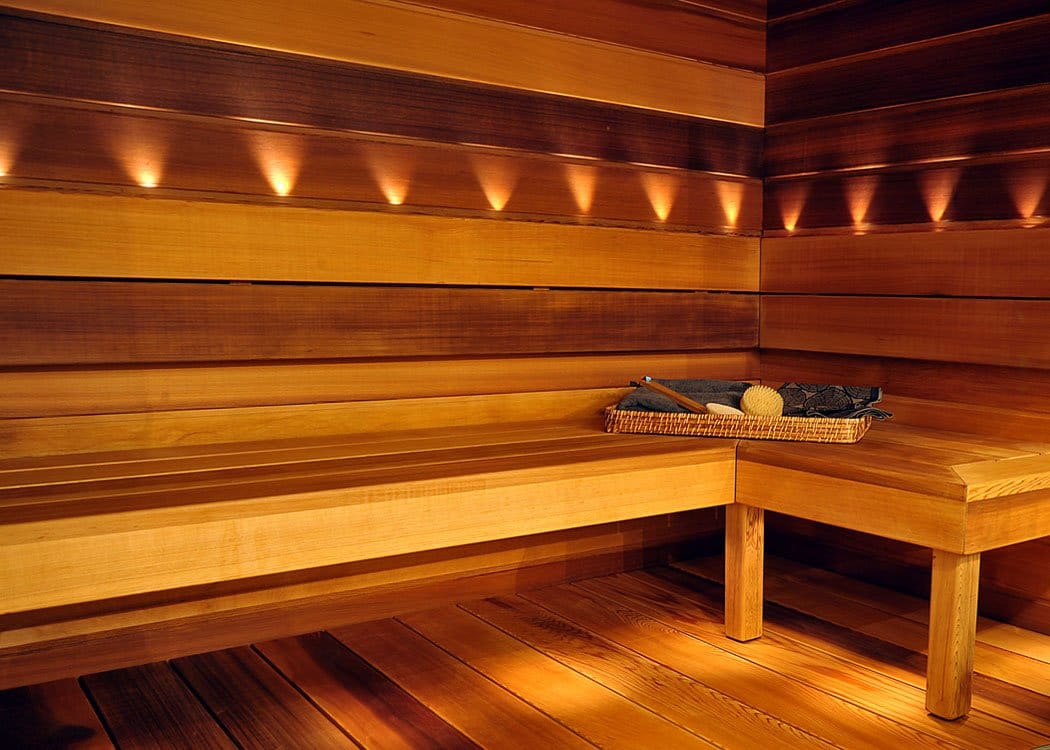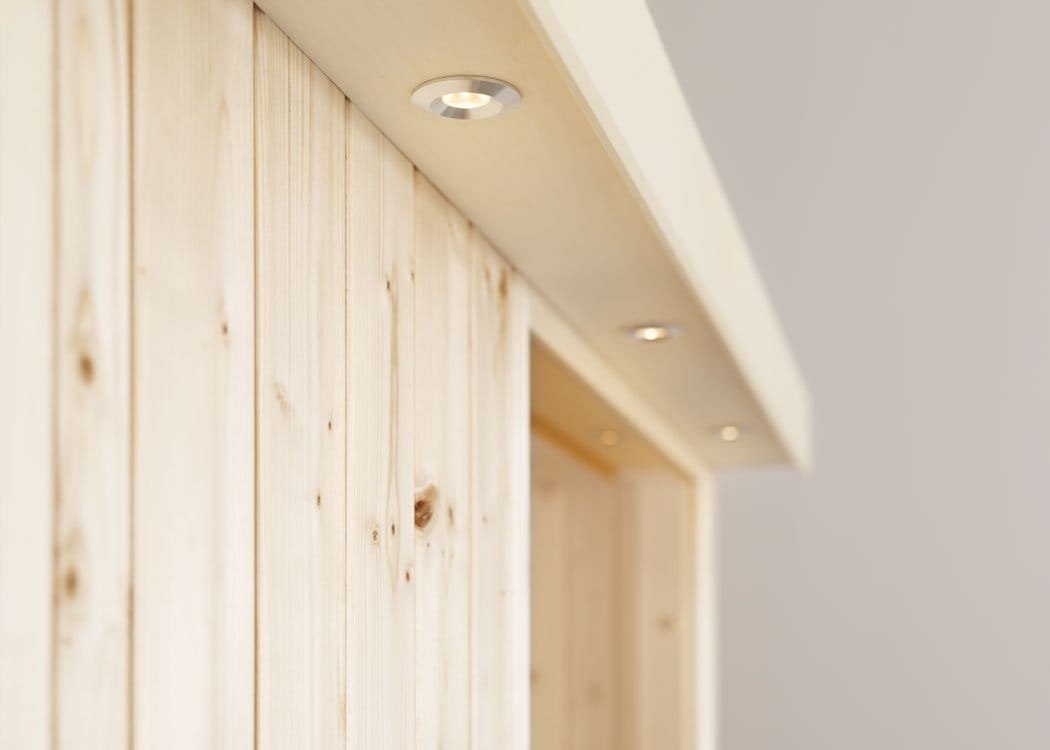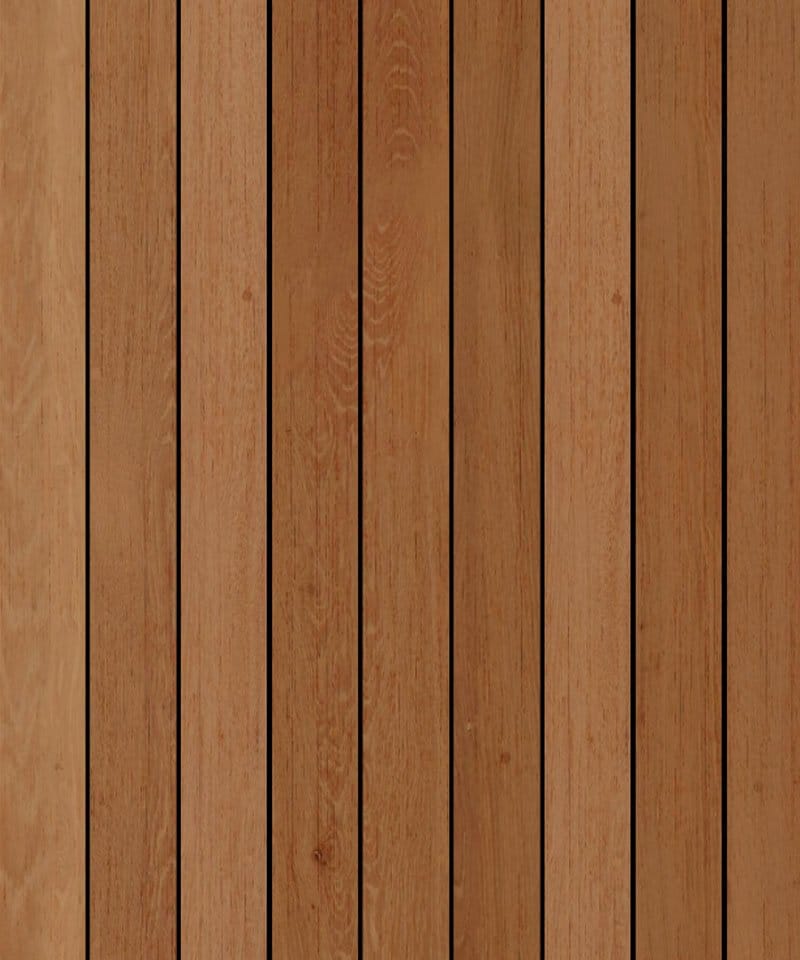Sauna wood is typically different from other wood panels because it is specifically designed and treated for use in high-temperature and high-humidity environments. The best wood for sauna building is generally kiln-dried. It’s also carefully selected to ensure it is free of knots and other defects that could cause the wood to crack or split under extreme conditions.
In addition, sauna wood is typically treated with a special sauna oil or wax that helps to protect it from the moisture and high temperatures inside the sauna. This treatment also enhances the natural beauty of the wood and helps to prevent it from drying out or becoming brittle over time.
Table of contents
It is important to note that not all types of wood are suitable for constructing a sauna. Some woods, such as pine, may release resin or other harmful substances when heated. Others may warp or crack under the extreme conditions of a sauna. Cedar and hemlock are two of the best wood types for sauna building. This is because they are naturally resistant to decay and insects, have good insulation properties, and are less likely to warp or crack.
Common wood types used in sauna construction
When it comes to choosing the type of wood to use in a sauna, there are a few things to consider such as durability, heat resistance, and suitability for use in high humidity environments. Here are some of the most popular options:
- Cedar: is a popular choice for sauna construction because it is naturally resistant to decay, insects and daily use. It also has a pleasant aroma and excellent insulation properties, which means it retains heat well.
- Hemlock: is another popular option for sauna construction because it is durable, stable, and has a low rate of expansion and contraction. It also has a uniform texture and a pleasant aroma.
- Spruce: is a cost-effective option for sauna construction, and it has good thermal insulation properties. However, it is not as durable as cedar or hemlock and can be prone to warping and cracking.
- Pine: is a commonly used wood in sauna construction. It is not as durable as cedar or hemlock and can be prone to warping and cracking. Notably, it has a pleasant aroma, but it is not as heat-resistant as other woods.
Ultimately, the choice of the best wood for a sauna will depend on personal preferences and budget. That said, cedar and hemlock are generally considered the best options.

There are many types of sauna woods such as spruce, aspen, hemlock and more.
The most popular woods for sauna building
The most popular sauna woods are cedar and hemlock. Both of these woods have been used in home and commercial sauna construction for centuries and are highly prized for their durability, resistance to decay, and pleasant aroma.
Cedar is a popular choice for saunas because it is naturally resistant to decay and insects. It also has good insulation properties, and has a pleasant aroma that can help to enhance the sauna experience. Cedar is also easy to work with and is often used in traditional Finnish sauna construction.
Hemlock is another popular choice for saunas because it is durable, stable, and has a low rate of expansion and contraction. Hemlock is also less expensive than cedar and has a uniform texture and pleasant aroma.
While cedar and hemlock are the most popular sauna woods, other types of wood such as kiln dried spruce, pine, and aspen are also regularly used. However, it’s important to ensure that any wood used in a sauna is treated and selected specifically for sauna use.

Hemlock is considered one of the best woods for sauna building.
The overall best wood for sauna building
Depending on your budget, the best wood for saunas can be a matter of personal preference. That said, cedar and hemlock are considered the top choices for sauna wood due to their durability and resistance to decay. Furthermore, they are suitable for continued use in high temperature and humid environments.
Cedar is a popular choice for sauna building due to its natural resistance to decay, good insulation properties and pleasant aroma. Cedar is also easy to work with and is often used in traditional Finnish sauna construction.
Hemlock is another popular choice for saunas due to its durability, stability, and low rate of expansion and contraction. Hemlock is also less expensive than cedar and has a uniform texture and pleasant aroma. It is important to ensure that any wood used in a sauna is treated and selected specifically for sauna use.
Ultimately, the best wood for your sauna will depend on personal preferences, budget, and availability. Cedar and hemlock are considered the top choices. This is due to their long-standing use in sauna construction and excellent performance in high-temperature and high-humidity environments.
Four reasons hemlock is better than cedar for saunas
Cedar and hemlock are both excellent choices for sauna wood, but hemlock has a few advantages over cedar that make it a preferred choice for some sauna builders.
- Durability: Hemlock is a harder and denser wood than cedar. This makes it more resistant to dents, scratches, and wear over time. Hemlock is less likely to dent or deform under the weight of sauna users or from accidental impacts.
- Stability: Hemlock has a lower rate of expansion and contraction than cedar, which means it is less likely to warp or crack over time due to changes in temperature and humidity inside the sauna.
- Cost: Hemlock is generally less expensive than cedar, making it a more budget-friendly option for sauna builders.
- Appearance: Hemlock has a more uniform texture and grain pattern than cedar, which some people prefer for the clean and modern aesthetic it provides.
That being said, cedar is still an excellent choice for sauna wood. Ultimately, the choice between hemlock and cedar will depend on personal preferences.

Canadian red cedar is one of the most expensive sauna woods but not always the best.
The most expensive sauna wood
The most expensive sauna wood is generally considered to be Canadian red cedar. Canadian red cedar is a premium grade cedar that is prized for its beautiful colour, rich aroma, and natural resistance to decay and insects. It is often used in high-end sauna construction. As a result it can be significantly more expensive than other types of sauna wood, such as hemlock or aspen.
Other types of wood can also be expensive, depending on the quality and availability. For example, clear Western red cedar and clear vertical grain hemlock are also premium grades of wood that can command higher prices. In general, the cost of sauna wood will depend on factors such as the species, grade, thickness, and source of the wood, as well as the location and availability of the wood.
The cheapest sauna wood
If you’re on a budget then you might want to consider the cheapest sauna wood. Typically this will be a softwood such as spruce or pine. Generally, spruce is considered the most budget-friendly sauna wood. However, the exact cost will vary depending on your location and local availability. For example; local softwoods will be cheaper than imported softwoods.
While spruce and pine are the best value sauna wood, it’s important to consider the overall quality of the wood. Factors like knots, moisture content, and so on should all be considered along with price. Saving money on materials may initially seem attractive, but investing in higher-quality wood can extend the life of your sauna. The cheapest sauna wood is rarely the best option. Proper wood selection and regular maintenance are key to ensuring your sauna remains safe and comfortable for the long term.
Traditional sauna wood used by the Finnish people
The Finnish traditionally use Nordic spruce or Nordic pine for saunas. Nordic spruce is a slow-growing tree that has tight growth rings and a uniform texture. This makes it a durable and stable wood for sauna construction. Nordic pine is also a popular choice for saunas in Finland, as it has similar properties to Nordic spruce and a pleasant aroma.
In addition to spruce and pine, Finnish sauna builders may also use other types of wood. Popular choices are as aspen or alder, depending on personal preferences. However, the use of spruce and pine is deeply rooted in Finnish sauna culture. as a result, it remains a popular choice for sauna construction in Finland and around the world.
Five best woods for a traditional sauna design
The type of wood used in a traditional sauna can vary depending on the region and culture, but some common woods used in traditional saunas include:
- Nordic spruce: This slow-growing tree has tight growth rings and a uniform texture, making it a durable and stable. Nordic spruce is commonly used in Finnish saunas.
- Nordic pine: This tree has similar properties to Nordic spruce and a pleasant aroma. It is a popular choice for sauna construction in Finland and other Nordic countries.
- Cedar: Cedar is a popular choice for saunas in North America due to its natural resistance to decay and insects, good insulation properties, and pleasant aroma.
- Hemlock: Hemlock is another popular choice for saunas in North America due to its durability, stability, and low rate of expansion and contraction.
- Aspen: Aspen is a lightweight and affordable wood that is commonly used in saunas in Europe and North America. It has a light colour and a subtle, pleasant aroma.

The light aroma and finish of Nordic pine makes it a popular sauna wood choice.
Choose thermo-treated sauna wood for durability
Thermo-treated is wood that has been heat-treated to improve its properties for use in saunas. Thermo-treatment is a process that involves heating wood to high temperatures in the absence of oxygen. This causes chemical and structural changes in the wood.
During the thermo-treatment process, the wood is heated to temperatures of around 180-220°C (356-428°F) in a kiln, without exposure to oxygen. This causes the wood to release moisture and volatile organic compounds. The end result makes it more stable, durable, and resistant to decay, insects, and warping. The heat treatment also changes the colour of the wood, making it darker and more uniform in appearance.
Thermo-treated wood has several advantages for sauna use. These include improved dimensional stability, reduced risk of warping, cracking, or splitting, and reduced moisture content. Thermo-treated wood is also more resistant to decay, which can extend the lifespan of the sauna. It is available in different wood types, including cedar, spruce, and hemlock. Notably, it is becoming increasingly popular for sauna construction due to its improved properties and durability.
On a budget? Not on a budget?
If budget is not a concern, and you want the best wood for your sauna, cedar and hemlock are considered the top choices. Both cedar and hemlock have excellent properties that make them suitable for sauna use.
If you are on a budget, spruce or pine are more affordable options that can still provide a durable and stable sauna. Aspen is also a lightweight and affordable wood that is commonly used in saunas in Europe and North America.
Five types of wood not suitable for saunas
There are several types of wood that are not recommended for use in saunas due to their properties or potential health risks. These include:
- Pressure-treated wood: Pressure-treated wood is treated with chemicals to make it more resistant to decay and insects. However, the chemicals can release harmful vapours when heated, making it unsuitable for sauna use.
- Green or unseasoned wood: Green or unseasoned wood has a high moisture content. This can cause it to warp, crack, or split when exposed to high temperatures and humidity in a sauna.
- Wood with high resin content: Wood with high resin content, such as pine, can release volatile organic compounds when heated. This can cause respiratory irritation and other health problems.
- Wood with toxic properties: Some types of wood, such as yew, can have toxic properties that can cause health problems when heated.
- Wood with low durability: Wood such as poplar, are not as durable as other woods. As a result they are not suitable for use in a high-temperature, high-humidity environment like a sauna.
Overall, it is important to choose a wood that is specifically treated and selected for sauna use to ensure durability, safety, and a pleasant sauna experience.
Frequently asked questions
Is pine OK for a sauna?
Pine is an acceptable wood for sauna use, but it’s not the best choice. Pine has a tendency to release resin at high temperatures, which can create an unpleasant odour and may even pose a health risk if inhaled. Other woods, such as cedar, hemlock, or aspen, are better choices for sauna construction.
What is the cheapest timber to use in a sauna?
The cheapest timber to use in a sauna depends on your location and availability of different wood types. In general, aspen and spruce are usually the most affordable sauna woods. However, keep in mind that cheaper woods may require more maintenance or may not last as long as higher quality woods.
What is the best material to build a sauna?
The best material to build a sauna is typically a type of softwood, such as cedar, hemlock, aspen, or spruce. These woods have a low thermal conductivity, meaning they don’t conduct heat as easily as other materials, which helps to keep the heat inside the sauna. Softwoods also have a pleasant aroma and are resistant to rot and decay.
How thick should sauna wood be?
The thickness of the sauna wood depends on the type of wood and how it’s being used. In general, sauna wood should be at least 1 inch (2.5 cm) thick for the walls, ceiling, and benches.
How thick should sauna walls be?
The recommended thickness for sauna walls is typically 2 inches (5 cm) or more. Thicker walls help to insulate the sauna and keep heat inside.
What kind of wood is used for a wood-burning sauna?
The wood used for a wood-burning sauna should be a type of hardwood, such as oak, birch, or maple. Hardwoods are denser and more heat-resistant than softwoods, making them better suited for use in high-temperature environments.
Is cedar or eucalyptus wood better for sauna?
Both cedar and eucalyptus wood are suitable for use in a sauna, but cedar is more commonly used because of its pleasant aroma, resistance to decay, and low thermal conductivity.
What wood can withstand high heat?
The wood that can withstand high heat includes hardwoods, such as oak, birch, and maple, and certain softwoods, such as cedar, hemlock, aspen, and spruce. These woods have a low thermal conductivity, meaning they don’t conduct heat as easily as other materials, which helps to keep the heat inside the sauna.
Can you use treated wood to build a sauna?
Treated wood should not be used to build a sauna. Treated wood is typically treated with chemicals that can release harmful fumes when heated, posing a health risk to those using the sauna. It’s best to stick to untreated, natural wood for sauna construction.










Hello Kenton. I am in Ireland and wish to build a barrel sauna for use down by the sea. I like spruce timber especially the light color. Would it be alright to build the barrel sauna out of spruce staves maybe 2 and a half inches thick. I know it has a bad reputation for durability but I dont mind doing a bit of maintenance. I suppose I’m just wondering is there any reason why I couldbt use irish grown spruce. It is so readily available here and fairly cheap. Any advice would be great. When I get her built may come back and buy a stove and few bits and pieces from Yourself.
Thanks
Conor Tuite
Donegal
Ireland
Hi Conor, your comment will be replied to via email. Thanks.
Hallo,ich habe eine Frage. Ich plane gerade meine Innen- Sauna in meinen Wintergarten ind ich habe Bretter aus Douglasienholz die schon seit über 20 Jahren trocken gelagert sind. Ist Douglasie für eine Sauna geeignet? Ich freue mich auf Ihre Antwort
Herzlichen Dank
Hi Dieter, our understanding is that you can use Douglas Fir to build your sauna.
Hi Kenton! Thank you so much, so informative and very helpful! I am looking for an easy “plug & play” 2-person sauna for home use. Is there a brand/model that you recommend?
Hi Myah, your request is with a member of the team. Thanks.